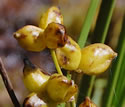Scheuchzeria palustris (Rannoch-rush)
| Also known as: | Pod Grass, Scheuchzeria |
|---|---|
| Genus: | Scheuchzeria |
| Family: | Scheuchzeriaceae (Pod-grass) |
| Life cycle: | perennial |
| Origin: | native |
| Habitat: | sun; wet; bogs, fens |
| Bloom season: | May - July |
| Plant height: | 4 to 16 inches |
| Wetland Indicator Status: | GP: OBL MW: OBL NCNE: OBL |
| MN county distribution (click map to enlarge): |  |
| National distribution (click map to enlarge): |  |
Pick an image for a larger view. See the glossary for icon descriptions.
Detailed Information
Flower: 

![[photo of flowers]](/udata/r9ndp23q/pd/scheuchzeria-palustris-061716-17-t.jpg) Raceme of 3 to 6 stalked flowers alternately arranged at the top of the stem. Flowers are about ¼ inch across with 6 lance-oblong tepals (petals and similar sepals) about 1/8 inch long. In the center are 3 large, erect pistils, generally egg-shaped with an oblong, short-hairy, whitish style along the upper edge that loses its hairiness soon after pollination. Surrounding the pistils are 6 stamens with long, linear-oblong tips (anthers). Color of most flower parts varies from creamy white to green to purple to brown. The flower stalk is up to ¾ inch long, green to purplish, and has a long sheathing bract at the base. Lower bracts are leaf-like becoming more scale-like as they ascend the stem.
Raceme of 3 to 6 stalked flowers alternately arranged at the top of the stem. Flowers are about ¼ inch across with 6 lance-oblong tepals (petals and similar sepals) about 1/8 inch long. In the center are 3 large, erect pistils, generally egg-shaped with an oblong, short-hairy, whitish style along the upper edge that loses its hairiness soon after pollination. Surrounding the pistils are 6 stamens with long, linear-oblong tips (anthers). Color of most flower parts varies from creamy white to green to purple to brown. The flower stalk is up to ¾ inch long, green to purplish, and has a long sheathing bract at the base. Lower bracts are leaf-like becoming more scale-like as they ascend the stem.
Leaves and stems: 

![[photo of leaves]](/udata/r9ndp23q/pd/scheuchzeria-palustris-061716-1-t.jpg) Leaves are grass-like, erect to ascending, about 1/8 inch wide, toothless, hairless, stalkless, with numerous parallel veins and an open pore at the tip, like a small hole. Lowest leaves are longest, up to 16 inches, becoming smaller as they ascend the stem with the uppermost reduced to bracts.
Leaves are grass-like, erect to ascending, about 1/8 inch wide, toothless, hairless, stalkless, with numerous parallel veins and an open pore at the tip, like a small hole. Lowest leaves are longest, up to 16 inches, becoming smaller as they ascend the stem with the uppermost reduced to bracts.
![[photo of sheaths]](/udata/r9ndp23q/pd/scheuchzeria-palustris-061716-12-t.jpg) Leaf bases sheath the stem and have a ligule (membrane where the sheath meets the blade) up to ½ inch long. Stems are erect, single or a few from the base, hairless, green to purple, and are rarely longer than 10 inches, usually shorter than the longest leaves. Colonies are formed from scaly, branching rhizomes.
Leaf bases sheath the stem and have a ligule (membrane where the sheath meets the blade) up to ½ inch long. Stems are erect, single or a few from the base, hairless, green to purple, and are rarely longer than 10 inches, usually shorter than the longest leaves. Colonies are formed from scaly, branching rhizomes.
Fruit: 
![[photo of fruit]](/udata/r9ndp23q/pd/scheuchzeria-palustris-7170925-2-t.jpg) The 3 erect pistils become spreading capsules as fruits mature, initially green turning yellowish and about ¼ inch or so long when ripe. Each capsule contains 2 seeds.
The 3 erect pistils become spreading capsules as fruits mature, initially green turning yellowish and about ¼ inch or so long when ripe. Each capsule contains 2 seeds.
![[close-up of seed]](/udata/r9ndp23q/pd/scheuchzeria-palustris-110616-1-t.jpg) Seeds are dark brown to blackish, elliptic, 4 to 5 mm long.
Seeds are dark brown to blackish, elliptic, 4 to 5 mm long.
Notes:
Rannoch-rush is a strange little plant, limited mostly to open, sphagnum bogs, and has a circumpolar distribution. Sometimes commonly called Pod-grass, it is not a grass at all, though it does have grass-like leaves. It is the only member of the Scheuchzeris genus, as well as the only member of the Scheuchzeriaceae family, in North America. It's not especially showy and easily missed unless you happen to look down to see what's coming up in the moss. The fruit can be more eye-catching than the flowers. It is not likely to be confused with any other plant. Even when flowers or fruits are not present, it can be identified by the open pore at leaf tips.
Native Plant Nurseries, Restoration and Landscaping Services ↓
More photos
Photos by K. Chayka taken in Aitkin and Lake counties. Photos courtesy Peter M. Dziuk taken in Aiktin, Anoka and Lake counties.
Comments
Have you seen this plant in Minnesota, or have any other comments about it?







 Rannoch-rush plants
Rannoch-rush plants Rannoch-rush plants
Rannoch-rush plants Rannoch-rush plants
Rannoch-rush plants plant with mature fruit
plant with mature fruit